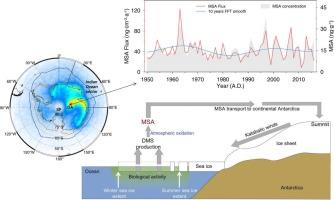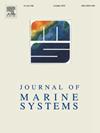A reconstruction of Antarctic Sea ice extent since the 1950s from a snowpit methanesulfonate (MSA) record in East Antarctic inland
IF 2.5
3区 地球科学
Q2 GEOSCIENCES, MULTIDISCIPLINARY
引用次数: 0
Abstract
Antarctic sea ice plays a crucial role in regulating regional and global climate, as well as ecosystem productivity of the Southern Ocean. Since sea ice data were rare before 1978C.E., reconstruction of past sea ice conditions is of vital importance for understanding their impact on past climate change. Methanesulfonate (MSA) in Antarctic ice cores is considered a potential proxy of sea ice extent (SIE). In this study, we tested this approach by measuring the variations of MSA flux (1950–2016C.E.) in samples collected from a snowpit at Dome A, the summit of Eastern Antarctic ice sheet, and investigating its relationship with the SIE in the Southern Ocean. The result shows a significant and positive correlation between the MSA flux and the observed mean SIE in the Indian Ocean sector of the Southern Ocean from 1979 to 2016C.E. In addition, our study shows that the MSA is mainly influenced by Southern Hemisphere westerly winds (zonal winds) and katabatic winds (flowing from inland to the coast). Enhanced winds in both systems promote sea ice production in the Southern Ocean. These wind systems significantly influence the MSA cycle, stronger westerlies and katabatic winds increase MSA production, whereas meridional winds facilitate the transport and subsequent deposition of MSA at Dome A. Our findings suggest that MSA recorded in snow from Dome A could serve as a reliable proxy or reconstruction for mean SIE. Consequently, MSA in deep ice cores from Dome A offers a valuable archive for investigating past sea ice conditions in the Indian Ocean sector of the Southern Ocean, biogenic sulfur, and their climatic impacts.

根据南极东部内陆的一个雪坑甲烷磺酸盐(MSA)记录重建了20世纪50年代以来的南极海冰范围
南极海冰在调节区域和全球气候以及南大洋生态系统生产力方面发挥着至关重要的作用。因为海冰数据在1978年以前是很罕见的。重建过去的海冰状况对于了解它们对过去气候变化的影响至关重要。南极冰芯中的甲烷磺酸盐(MSA)被认为是海冰范围(SIE)的潜在代用物。在本研究中,我们通过测量从南极东部冰盖顶部Dome a的雪坑收集的样品中MSA通量的变化(1950 - 2016ce .),并研究其与南大洋SIE的关系,验证了这一方法。结果表明,1979 - 2016ce期间南大洋印度洋段MSA通量与观测到的平均SIE呈显著正相关。此外,我们的研究表明,MSA主要受南半球西风(纬向风)和倒转风(从内陆流向海岸)的影响。这两个系统中风力的增强促进了南大洋海冰的形成。这些风系统显著影响MSA循环,较强的西风带和倒转风增加了MSA的产生,而经向风促进了MSA在Dome A的运输和随后的沉积。我们的研究结果表明,Dome A雪中记录的MSA可以作为平均SIE的可靠代理或重建。因此,Dome A深层冰芯中的MSA为研究南大洋印度洋部分过去的海冰状况、生物硫及其气候影响提供了宝贵的档案。
本文章由计算机程序翻译,如有差异,请以英文原文为准。
求助全文
约1分钟内获得全文
求助全文
来源期刊

Journal of Marine Systems
地学-地球科学综合
CiteScore
6.20
自引率
3.60%
发文量
81
审稿时长
6 months
期刊介绍:
The Journal of Marine Systems provides a medium for interdisciplinary exchange between physical, chemical and biological oceanographers and marine geologists. The journal welcomes original research papers and review articles. Preference will be given to interdisciplinary approaches to marine systems.
 求助内容:
求助内容: 应助结果提醒方式:
应助结果提醒方式:


